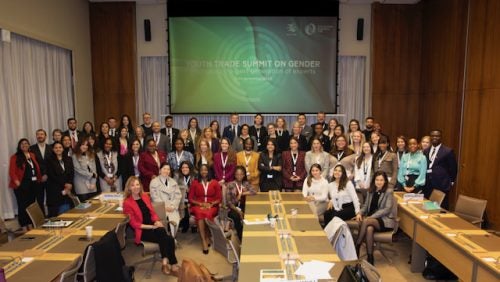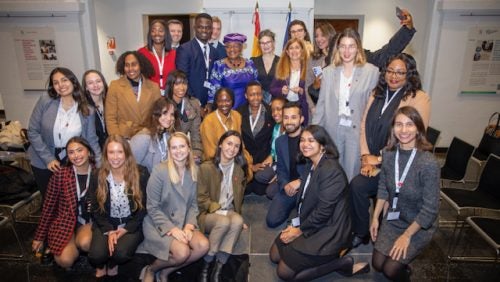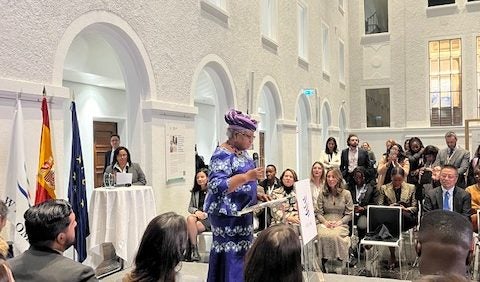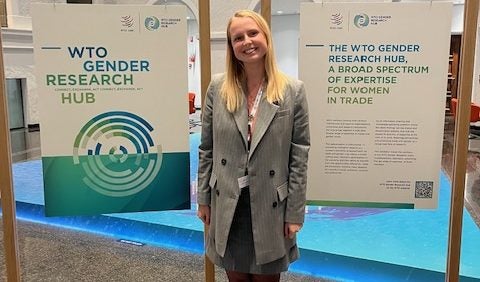The Youth Trade Summit on Gender
The Youth Trade Summit on Gender: Three Lessons and Priorities
On the 13th and 14th of November, the WTO Gender Research Hub held the first-ever Youth Trade Summit on Gender bringing together young professionals, researchers and leading gender and trade champions.[1] The two-day summit provided a unique opportunity for young researchers to build knowledge and capacity at the trade and gender nexus. This Summit followed the first World Trade Congress on Gender held in December 2022, attended by CITD co-director Professor Katrin Kuhlmann.[2]
Beyond being a fundamental right and social justice issue, gender equity is a development imperative. Empowering women to participate in trade has significant economic implications, as do the barriers and the distributional inequalities that prevent them from doing so. According to the World Bank, women only contribute to 37 percent of global GDP despite being half of the world’s population.[3] Identifying and addressing these challenges is paramount to ensuring that women not only participate in trade but also reap its benefits and avoid its negative externalities. The Summit examined a broad range of issues and challenges related to gender equality in trade ranging from rights to representation to resources. This blogpost highlights three key challenges identified and just some of the many ideas proposed by Summit to address these challenges.
- Data
Data plays a critical role in identifying and understanding gender disparities in trade and designing of trade policy to address these challenges.[4] However, there is a severe shortage of reliable and comprehensive gender-specific trade data undermining inclusive trade policy.[5] At present, the assumption that trade is gender-neutral prevents the collection of data in a way that allows gender disaggregation or even age disaggregation and prevents the identification of patterns and barriers.[6] However, collecting data and conducting analyses to identify patterns requires resources that no one government, international organization, or private entity has, particularly when it comes to the informal economy, where women are disproportionately active and data is particularly difficult to collect. Rather there must be a collective effort at every level to ensure that the quantity of disaggregated data is improved in a qualitative way. Participants in the Summit brainstormed recommendations to address this issue and proposed ideas such as encouraging countries that are already reporting on gender in their trade policy reviews to demand the same of countries that are not yet doing within the trade policy review mechanism. Another recommendation was to encourage comparative studies of this data to be conducted to identify and analyze similarities and differences in the challenges that women face across different regions when engaging in trade.
- Financing
Trade finance plays a critical role in trade by providing security and mitigating the risks associated with transactions across borders.[7] However, there is a chronic shortage of trade finance available, particularly in developing countries. Additionally women, especially those engaged in small to medium-sized enterprises and the informal economy, face greater barriers to gaining access to these instruments than the general population.[8] This is due to the features of trade finance markets not being designed with women or MSMEs in mind. The World Economic Forum estimates that even a basic bank account is beyond the reach of nearly one billion women worldwide. Even where they do have this, the average size of economic activity needed to use instruments such as a letter of credit is estimated at USD 2 million.[9] Obtaining finance instruments also requires collateral as security, this requires assets such as land or a house which women many countries women have limited access to.[10] Even where they have the means to secure financing, the process of obtaining these instruments is complex and opaque, making the administrative burden too high for many MSMEs and the women engaged in these enterprises. Participants suggested ideas to improve the financial system to be more flexible and accessible for women and MSMEs, such as expanding the range of instruments available and the beneficiaries who may apply for them. They also emphasized the importance of training and capacity building focused on teaching women about trade finance options and procedures. Fintech was identified as a useful tool to improve access, although the current digital divide between men and women was acknowledged as an obstacle to its effectiveness.
- Vulnerability in “polycrisis”
In a world of “polycrisis” – a collection of disparate crises that are interconnected and contribute to a global state of crisis – women are among the most vulnerable.[11] For example, the impacts of climate change will be carried disproportionately by women as they face higher risks and greater burdens because of the roles they traditionally take up in the economy.[12] In many regions, women carry the primary responsibility for securing food, water and fuel and are disproportionately present in the agricultural sector.[13] As temperatures rise, periods of drought and erratic rainfall impact women’s ability to secure an income.[14] These challenges emphasize the importance of considering women in particular in the design of trade and climate mitigation and adaptation efforts. It is not only important to have focused gender and trade research but imperative that gender considerations are mainstreamed across trade policy design and implementation. Moreover, women are agents of change. Research shows that countries with high representation of women in parliament are more likely to ratify international environmental treaties and communities led by women are more successful at including climate resilience and capacity-building strategies.[15] Despite this, women continue to be underrepresented in high-level and decision-making functions globally.[16] Representation was emphasized throughout the Summit as a critical element in designing gender-responsive trade policy.
In conclusion, the inaugural Youth Trade Summit on Gender stands as a pivotal moment in the ongoing discourse on trade and gender equity. Looking at just three key challenges: data, trade finance and vulnerability, there is much work to do at the nexus of trade and gender to improve gender equality and make it an effective tool for development. The summit highlights the importance of collective effort at every level to ensure that policymaking is gender-responsive and fosters a more inclusive and equitable global trade landscape. Finally, bridging the gender gap will require not only addressing economic barriers but also the systemic and often cultural obstacles that women face in society. The Summit concluded with pledges from participants to continue applying a gender lens in their work and carry forward the knowledge gathered and work done at the Summit.
[1] WTO, ‘Youth Trade Summit on Gender to foster next generation of trade and gender experts’ (12 June 2023), https://www.wto.org/english/news_e/news23_e/women_12jun23_e.htm.
[2] The World Trade Congress on Gender took place from 5 to 7 December of 2022 in Geneva.
[3] The World Bank, ‘Trade and Gender’ (8 March 2019), https://www.worldbank.org/en/topic/trade/brief/trade-and-gender.
[4] OECD, ‘Gender-disaggregated data’ in Toolkit for Mainstreaming and Implementing Gender Equality implementing the 2015 OECD Recommendation Gender Equality in Public Life’ (Paris: OECD, 2015), https://www.oecd.org/gender/governance/toolkit/government/assessment-of-gender-impact/disaggregated-data/.
[5] UNCTAD, ‘Improving statistics on gender and trade in developing countries’ (30 August 2023), https://unctad.org/news/improving-statistics-gender-and-trade-developing-countries.
[6] OECD, ‘Trade and Gender’ (2023), https://www.oecd.org/trade/topics/trade-and-gender/ .
[7] International Trade Administration, ‘Trade Finance Guide’, https://www.trade.gov/report/trade-finance-guide.
[8] Alise DiCaprio, Ying Yao and Rebecca Simms, ‘Women and Trade: Gender’s Impact on Trade Finance and Fintech’ ADBI Working Paper Series No. 797 (2017).
[9] Statistic provided by expert at Youth Trade Summit Session on Trade Finance.
[10] Caroline Kende-Robb, ‘To improve women’s access to finance, stop asking them for collateral’ World Economic Forum (18 June 2019), https://www.weforum.org/agenda/2019/06/women-finance-least-developed-countriews-collateral/.
[11] Kate Whiting, ‘This is why ‘polycrisis’ is a useful way of looking at the world right now’ World Economic Forum (7 March 2023), https://www.weforum.org/agenda/2023/03/polycrisis-adam-tooze-historian-explains/.
[12] UNFCCC, ‘Five Reasons Why Climate Action Needs Women’ (8 March 2023), https://unfccc.int/news/five-reasons-why-climate-action-needs-women.
[13] UN Women, ‘Explainer: How gender inequality and climate change are interconnected’ (28 February 2022), https://www.unwomen.org/en/news-stories/explainer/2022/02/explainer-how-gender-inequality-and-climate-change-are-interconnected.
[14] Ibid.
[15]UNFCCC, ‘Five Reasons Why Climate Action Needs Women’ (8 March 2023), https://unfccc.int/news/five-reasons-why-climate-action-needs-women.
[16] UN Women, ‘Women in politics: 2023 map’ (2023), https://www.unwomen.org/en/digital-library/publications/2023/03/women-in-politics-map-2023.




